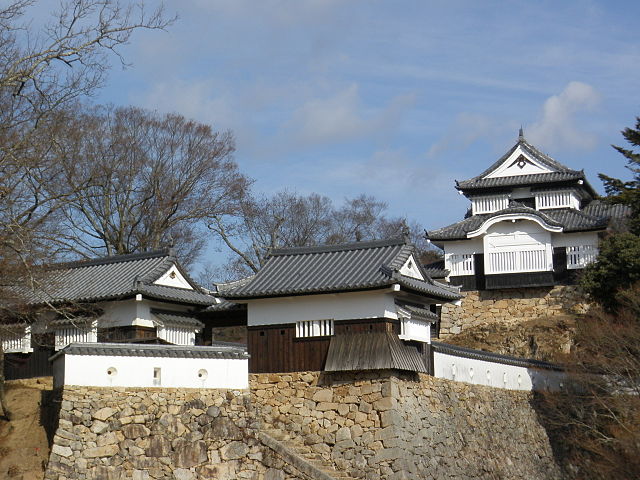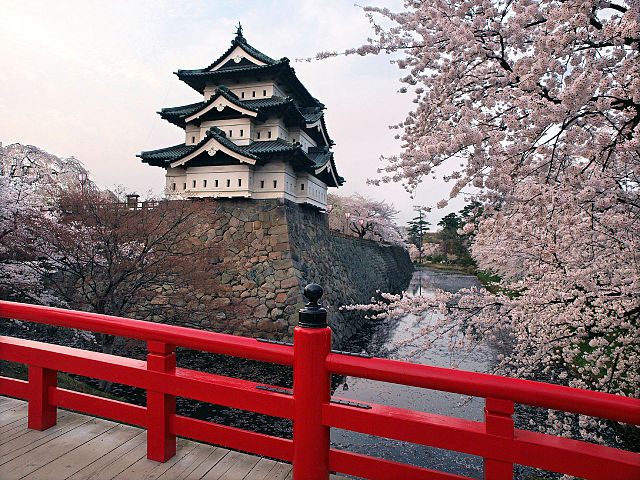Earlier in its history, Japan was not one whole country, but a collection of small feudal domains which, coincidentally enough, feuded with each other quite a bit. During the Warring States period of the mid-to-late 16th century AD, the leaders of these clans built castles to protect themselves. Even more were built afterwards, when the country was unified and the internally-peaceful Edo Period began. Today, long after the descendants of those regional leaders needed such physical protection, their castles live on, primary as museums about the history of the castles themselves and the region they represented.
An important distinction to make about Japanese castles is whether or not they are considered "original" castles. During the Meiji period (1868-1912), when the Emperor regained power and moved the capital to Tokyo, castles were seen as outdated relics of the "primitive" feudal age, and so many were destroyed. However, most of the destroyed castles were later rebuilt, either with concrete or, especially in recent years, with wood in a more traditional fashion. Only twelve castles are counted as "original castles", in that they have stood undisturbed since the end of the Edo period. As part of this list, I will indicate whether or not the castle is part of the original twelve, although just because a castle is not original does not mean it isn't worth your time; far from it. Also, in the interest of fairness, this list is not ordered by quality, but by geographic location, moving west to east along the country.
1) Shuri Castle, Okinawa
Original: No, rebuilt in 1992
 |
| By 663highland (Own work) [GFDL, CC-BY-SA-3.0 or CC BY 2.5], via Wikimedia Commons |
Note: Shuri Castle, pictured above, was destroyed again by fire
in October 2019. Current plans are to rebuild the damaged parts by
2026, but the castle park is still open in the meantime.
The islands of Okinawa used to be their own country, the Ryukyu Kingdom, until it was merged into Japanese territory in 1879. Most Okinawan castles, known in the local language as "gusuku", exist only by their distinctive thick-walled ramparts, but Shuri Castle (首里城, Shuri-jō, Okinawan: Sui Gusuku), near downtown Naha, takes it a step further. The buildings of the castle were shelled and mostly destroyed near the end of World War II, but have been rebuilt to their original splendour in recent years. The bright colours and architectural style of the castle's buildings show more of a Chinese influence than may be found elsewhere in Japan, due to Okinawa's closer location to the Asian continent.
Open from 8:30 AM to 7:00 PM; closes at 8:00 PM from July to September, or at 6:00 PM from December to March. Closed on the first Wednesday and Thursday of July. Costs ¥830. More information: (English) (Japanese)
2) Shimabara Castle, Nagasaki Prefecture
Original: No, rebuilt in 1964
 |
| 663highland [GFDL, CC-BY-SA-3.0 or CC BY 2.5], from Wikimedia Commons |
Open from 7:00 AM to 5:30 PM. Closed on 29 and 30 December. Costs ¥550. More information: (Japanese)
3) Matsue Castle, Shimane Prefecture
Original: Yes, built in 1611 (main keep only)
 |
| By 663highland [GFDL, CC-BY-SA-3.0 or CC BY 2.5], via Wikimedia Commons |
Open from 7:00 AM to 7:30 PM, or from 8:30 AM to 5:00 PM from October to March. Costs ¥680, or ¥340 with a foreign passport. More information: (Japanese)
4) Matsuyama Castle, Okayama Prefecture
Original: Yes, built in 1240
 |
| By User: (WT-shared) ChubbyWimbus at wts wikivoyage (Own work) [Public domain], via Wikimedia Commons |
*This castle is sometimes called Bitchu-Matsuyama Castle (備中松山城, Bicchū Matsuyama-jō), named after its former province, so as not to confuse it with the Matsuyama Castle in Matsuyama city, on Shikoku.
Open from 9:00 AM to 5:30 PM, or to 4:30 PM from October to March. Closed from 29 December to 3 January. Costs ¥500. More information: (Japanese)
5) Himeji Castle, Hyogo Prefecture
Original: Yes, built in 1609
Ask anyone to name a Japanese castle, and their answer may, more often than not, be Himeji Castle (姫路城, Himeji-jō). It is an imposing figure among castles, owing not only to its grand stature, but the labyrinthine passages and hidden defences which have deterred invaders for centuries. Indeed, Himeji Castle has been lucky enough to survive multiple brushes with near-destruction in its modern history. And yet, at the same time it expresses beauty through its brilliant white exterior, which has shone all the more after its recent restoration project. Of course, being of easy access to the cities of the Kansai region doesn't hurt either. I have also visited Himeji Castle myself; you may read about it here.
Open from 9:00 AM to 5:00 PM; closes at 6:00 PM from late April to August. Closed on 29 and 30 December. Costs ¥1,000, or ¥1,050 in combination with Koko-en Garden. More information: (English) (Japanese)
6) Nijo Castle, Kyoto
Original: Yes*, built in 1603
While most people associate Japanese castles with their main keeps, the sprawling, low-rise palace buildings at their base were more important. They served as the living quarters and reception halls for the resident shoguns during everyday operations, whereas the keeps were used more when the lord had to defend himself. Nijo Castle (二条城, Nijō-jō), in the centre of Kyoto, used to have a keep, but it was struck by lightning and burned down in 1750, and has never since been rebuilt. Instead, it now consists of two palace buildings: the outer Ninomaru, one of the few non-reconstructed castle palaces in Japan, and the inner Honmaru, which is very seldom open to the public. As visitors walk through the Ninomaru palace, they will discover one of its trademark features right under their feet: the "nightingale floors". These boards have nails underneath them which scrape hidden metal plates and emit a squeaking sound when stepped on, serving as a security measure back in the day.
*Because it no longer possesses a keep tower, Nijo Castle is not counted among the twelve original castles.
Open from 9:00 AM to 5:00 PM; opens at 8:00 AM from July to September; closes at 6:00 PM from July to August. Closed from 26 December to 3 January. Costs ¥620, or ¥1,030 including the Ninomaru palace. More information: (English) (Japanese)
7) Hikone Castle, Shiga Prefecture
Original: Yes, built in 1622
 |
| By Oilstreet (Oilstreet) [GFDL, CC-BY-SA-3.0 or CC BY 2.5], via Wikimedia Commons |
Open from 8:30 AM to 5:00 PM. Closed from 25 to 31 December. Costs ¥800, or ¥1,200 with Hikone Castle Museum. More information: (English) (Japanese)
8) Matsumoto Castle, Nagano Prefecture
Original: Yes, built in 1593
 |
| By Oren Rozen (Own work) [CC BY-SA 4.0], via Wikimedia Commons |
Open from 8:30 AM to 5:00 PM. Closed from 29 December to 1 January. Costs ¥610. More information: (English) (Japanese)
9) Tsuruga Castle, Fukushima Prefecture
Original: No, rebuilt in 1965
 |
| By Hiroaki Kaneko [CC BY-SA 3.0], via Wikimedia Commons |
Open from 8:30 AM to 5:00 PM. Costs ¥410. More information: (English) (Japanese)
10) Hirosaki Castle, Aomori Prefecture
Original: Yes, rebuilt in 1811
 |
| By Angaurits (my own work) [CC0], via Wikimedia Commons |
Note: From now through the year 2021, the main keep is going through renovations. In preparation for the process, the keep has manually (!) been hauled about 70 meters from its original location, shown above. So, while the keep is still open to the public, you'll have to wait a few years in order to once again take pictures like this.
Open from 9:00 AM to 5:00 PM. Closed from 24 November to late March/early April. Costs ¥320, or ¥520 in combination with the Fujita Botanical Garden. More information: (English) (Japanese)
Before the wildcard, I thought I'd throw in a few honourable mentions.
- Kumamoto Castle, Kumamoto Prefecture. Under normal circumstances, this reconstructed but complete castle would be a shoo-in for this list. Unfortunately, after an earthquake struck Kumamoto in April 2016, parts of the castle were seriously damaged, and so it remains closed while repairs are being performed. The city does not expect these repairs to be complete for another twenty years, but they hope to open the main keep as early as Spring 2021.
- Edit: As of 5 October 2019, a brief walking path around Kumamoto Castle's keeps has been opened to visitors. It is open only on Sundays and holidays, so as not to interfere with reconstruction work, and costs ¥500.
- Osaka Castle, Osaka Prefecture. Formerly Japan's largest castle, and currently Osaka's most popular cherry blossom site.
- Nagoya Castle, Aichi Prefecture. Its green-roofed keep is about to be closed for reconstruction, but its recently-rebuilt palace makes up for it.
- Matsumae Castle, Hokkaido. Located on the island's southern tip, this is the only traditionally-Japanese castle on Hokkaido.
- Goryokaku, Hokkaido. A Western-style, star-shaped fortress in the middle of Hakodate, and one of Hokkaido's most famous cherry-blossom sites.
Original: No
 |
| By Norio NAKAYAMA (Flickr: takeda castle) [CC BY-SA 2.0], via Wikimedia Commons |
Open from 8:00 AM to 6:00 PM (March-May), 6:00 AM to 6:00 PM (June-August), 4:00 AM to 5:00 PM (September-November), or 10:00 AM to 2:00 PM (December-3 January). Closed from 4 January to the end of February. Costs ¥500. More information: (Japanese)



